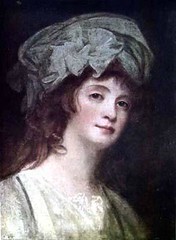 Madame de Genlis (1746-1830) was a French writer and educator. She was born to a noble but impoverished Burgundian family. At the age of six, she was received as canoness into the noble chapter of Alix, near Lyons, and received the title Madame la Comtesse de Lancy. Interestingly, she was entirely home educated. Her skill at the harp and her wit earned her admiration in Paris.
Madame de Genlis (1746-1830) was a French writer and educator. She was born to a noble but impoverished Burgundian family. At the age of six, she was received as canoness into the noble chapter of Alix, near Lyons, and received the title Madame la Comtesse de Lancy. Interestingly, she was entirely home educated. Her skill at the harp and her wit earned her admiration in Paris.She served as a governess to wealthy families, educating their children with zeal. She would see one of her students take the throne of France. She was a woman of the French Revolution, although she had to soon take refuge in Switzerland. Upon her return to France, she was well-received by Napolean Bonaparte who extended her a pension of 6,000 francs. She was a prolific writer (over 80 works), and anticipated many modern methods of education.
Like any good educator, she utilized the technology at hand to teach her young pupils. She utilized magic lantern slides to teach history. These were popular in the early 1800's and were a precursor to toda's film and television. She also took her children on nature walks where they learned botany from a practical botanist. One way she encouraged children to learn to appreciate the variety of plants and their parts was through games, such as making dolls from flowers.
Directions for a Poppy Doll
Materials:
poppy
blades of grass
Pick a poppy with at least five inches of stem. Bend down the front and back petals and tie them in the middle with a blade of grass. This will make the waistline and the doll's dress.
Take the side petals and bend them down, rolling them carefully into arms. Tie them at each end with a blade of grass. (Field poppies have four petals, so you will use one petal for each arm. Garden poppies may have eight, so you will use four for the skirt and two for each arm).
The carpel, or seed pod, serves as your doll's head. The stamens will form a collar.
(directions taken from Hidden Stories in Plants by Anne Pellowski)
This site provides a somewhat simpler poppy doll as it does not have you make the doll's arms.
I found this project intriguing and plan to try it with my daughter. Stay tuned for more crafts with products from nature! Let me know if you have any up your sleeves because I love these sorts of projects.
homeschooling, homes school, education, teaching science, botany, dolls
poppy
blades of grass
Pick a poppy with at least five inches of stem. Bend down the front and back petals and tie them in the middle with a blade of grass. This will make the waistline and the doll's dress.
Take the side petals and bend them down, rolling them carefully into arms. Tie them at each end with a blade of grass. (Field poppies have four petals, so you will use one petal for each arm. Garden poppies may have eight, so you will use four for the skirt and two for each arm).
The carpel, or seed pod, serves as your doll's head. The stamens will form a collar.
(directions taken from Hidden Stories in Plants by Anne Pellowski)
This site provides a somewhat simpler poppy doll as it does not have you make the doll's arms.
I found this project intriguing and plan to try it with my daughter. Stay tuned for more crafts with products from nature! Let me know if you have any up your sleeves because I love these sorts of projects.
homeschooling, homes school, education, teaching science, botany, dolls
